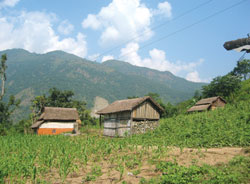|
|
Until four months ago, Phulmaya Praja's family lived 200 metres off the Prithibi Highway in complete darkness. They saw the lights of the trucks and buses on the road, but inside the home there was only the feeble light of kerosene lamps.
"We had to cook and eat before sunset, feel our way around the house at night in the dark, sleep early and our children had to study under a tuki," says Phulmaya.
Today, the Praja family is among the 90,000 households that the government and Nepal Electricity Authority (NEA) plan to electrify by July next year under a community rural electrification development program. Since 2003, community electrification has extended to 37 districts. NEA sells electricity in bulk to user groups at a substantially discounted rate of Rs 3.60 per unit, and they in turn sell it at a retail rate of up to Rs 4.50 per unit.
That is a lot less than what normal users pay and NEA doesn't have to be involved in distribution and fee collection-areas where its record is not so good.
"By distributing electricity via communities, NEA is saving on what they would have had to spend as operating costs," says Dilli Ghimire, chairman of the National Association of Community Electricity Users. At present there are over 107 user groups distributing electricity which are registered either as a cooperative, under the company act as a private limited company, under the social welfare act, or as non-profits.
"It reduced non-technical loss," explains energy economist Ratna Sansar Shrestha, "it's not NEA but the communities that monitor leakage, theft, so the management cost decreases, thereby also reducing distribution costs."
The program also facilitates a cost-effective rural electricity scheme by attracting private investments. A fund is set up in which the government contributes 80 percent and the community chips in the remaining 20 percent in cash or kind. "Word is spreading about the 80:20 program, people feel that they can also bring electricity to their communities," says Ghimire.
As with community radio or local management of forests, or irrigation, the program proves that de facto decentralisation is the best management option for Nepal. "Electricity generation can be private or public, its transmission has to be nationally managed like a highway, but distribution works well-and loss, especially theft, decreases dramatically-only when organised village groups and municipalities manage it," says former Water Resource Minister Dipak Gyawali who initiated this program in 2003 to 'communitise' electricity in Nepal.
Electricity lines may have reached rural areas, but there are still those families who live in total darkness because they cannot afford to pay the initial cost. To help such households organisations like Winrock International Nepal and local communities have set up a revolving fund in two pilot projects in south Lalitpur and Mugling, thereby helping to electrify over one hundred households in less than a year.
"The family takes a loan of Rs 1,500-2,000 to electrify its house, or use the money to start income generating activities, and eventually pays the loan in instalments over a period of time," says Bharat Raj Poudel of Winrock, which works on productive use of energy.
Communities that are adopting the electrification model are increasing but there are challenges ahead, mainly to do with tariffs. "It may be appropriate to sell electricity to some communities at Rs 3.50, but the same rate cannot be applied across the board," says Poudel.
Even with the 80:20 model, the 80 percent is actually not a grant to the community but goes to NEA, which doesn't start the project until the community also puts in its 20 percent share. The NEA treats the government's share as a loan or equity and thus ends up owning the system.
NEA's annual loss of Rs 2.5 billion can be cut by half if distribution of electricity is managed better. One way to fix this is to unbundle generation, transmission and distribution which NEA has been doing by itself since the 1980s. Says economist Shrestha: "We can follow the same model in the cities, let neighbourhood councils feel the ownership, the losses are cut, the process of unbundling begins, and everyone wins." Asian Development Bank (ADB) estimates it will cost them $300 to take electricity to every home in Nepal. The NEA and Butwal Power Company's community model shows that it will only cost $100 per home. It is clear Nepal needs a cheaper indigenous model for distribution.
Back in Mugling a community is ready to start a lift irrigation project. "Every member of the community has brought in a tool from home and we are all working hard to install a water tank," says Rana Bahadur Magar. His village is right above the Trisuli river but due to lack of irrigation Magar used to get only one crop a year. Now, using electricity to lift water from the river, the villagers hope to grow cauliflower, cabbage and other vegetables to sell in Mugling.
"A few years ago we were living in darkness," Magar tells visitors, "who would have thought that today we would be using electricity not only to light our homes but also to irrigate our fields?"



